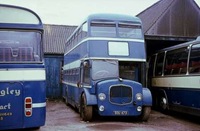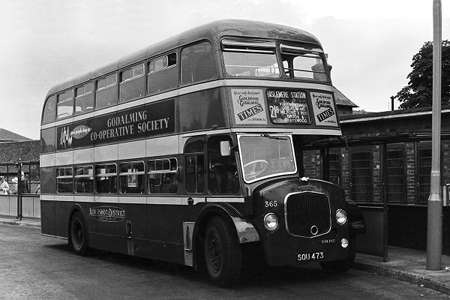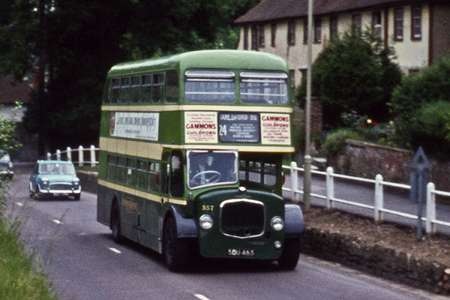United Services – Dennis Loline Mk I – SOU 473
United Services
1958
Dennis Loline MkI 6LW
East Lancs. H37/31RD
One of a batch of 34 Lolines delivered to Aldershot & District in 1958 numbered 336-369 (SOU 445-477), SOU 473 was withdrawn by them in 1969. It was then bought by W. R. & P. Bingley of Kinsley, who along with Cooper’s of South Elmsall and Everett’s of South Kirkby traded under the name ‘United Services’. It is pictured here resting at Bingley’s Upton depot in April 1973.
Photograph and Copy contributed by John Stringer
13/02/13 – 04:47
Here is a photograph of this bus when in service with its original owner, Aldershot and District. It is seen in Farnham Road bus station, Guildford in 1961. The Aldershot fleet was generally impeccably turned out, so that the tree damage to the front dome is surprising. The Loline I was a close copy of the Bristol LD Lodekka, but axles, clutch and gearbox were all of Dennis design. Unlike the Lodekka, the Loline always had a full air braking system. These Lolines were thoroughbreds to drive, better in every respect, in my estimation, to the Leyland PD2 and PD3, and the AEC Regent V machines that I had encountered at Halifax. Though equipped with the modestly powerful Gardner 6LW, which A&D rated at the full manufacturer’s setting, they were good performers, and, with a top speed touching 50 mph, quite fast for the time (1958) when they were introduced (and when the legal maximum speed for a PSV was 30 mph). The high quality East Lancs bodywork completed the specification of a supremely capable and reliable bus.
Roger Cox
13/02/13 – 04:50
Just between duties or withdrawn? Certainly not the pristine condition one normally associated with her original owner!
Pete Davies
13/02/13 – 14:43
I suppose that replacing a dented panel or wing to maintain standards of presentation was one thing, but straightening out a roof dome once battered by trees would be rather a big job – time consuming and therefore expensive, and the chances were that once done there was a distinct likely hood of it returning again with the same problem soon after.
John Stringer
15/02/13 – 12:06
Good to see these pictures of a superbly well-proportioned bus with, as Roger points out, first-rate innards to match. And if the 6LW was modestly-powered on paper, 112GHP (Gardner horsepower) was worth 125 of anyone else’s. Two of this batch fortunately survive: SOU 465, a regular attender at events, and SOU 456, still under restoration.
I prefer the Loline I radiator-grille shape to the later square-with-rounded-corners design.
I’ve got a Loline maintenance manual with sectional drawings of a bewildering variety of alternative gearboxes. Apparently they even offered a six-speed version, which I’m sure was never fitted to a production bus. I’ll post them here soon.
Ian Thompson
15/02/13 – 17:07
Ian, your extensive knowledge of, and fellow enthusiasm for Dennis machinery is very welcome on this site. I certainly never knew that a six speed option was available for the Loline. That would have given a 6LX powered bus an extraordinary performance. The generally accepted view is that the Loline was little more than a licence built Lodekka, but this is an over simplification, particularly in the case of the Loline III. I think I am right in believing that even the Loline I had a gearbox (the ‘V’ type?) that lowered the transmission line without the need for transfer gears as fitted to the Lodekka. The Loline transmission would have thus been more positive and efficient than the Bristol equivalent. The pre Hestair Dennis company had a high level of engineering expertise, but its commercial policies were very indecisive and often misguided. The firm nearly fell victim to a takeover by Seddon before Hestair became interested. Had that happened, or had Leyland made a move to gobble up the Guildford manufacturer, the outcome would surely have been oblivion. ADL may be a different animal from the Dennis of fond memory, and, alas, the superb fire engine business is no more, but it is the only significant bus chassis manufacturer now left in the UK.
Roger Cox
16/02/13 – 07:16
I think SOU 473 was bought by Everett’s in spring 1969, and later passed to Bingleys when Everett’s ceased to operate. I have no record of the takeover date or SOU’s withdrawal date, if anyone knows, please tell me! This was a superb bus to travel in, very speedy and much more spacious than any previous United Services vehicle. The rear door was air-powered, sliding forward into a pocket – when opened whilst decelerating for a stop, it crashed heavily onto the front of the pocket, no chance of dozing off despite the comfortable seats.
Roger Townend
16/02/13 – 07:17
I have a Loline sales brochure from about 1960 and this shows that the standard gearbox offering was the 5 speed V type. Interestingly a 4 speed SCG epicyclic was also offered but I have no knowledge of it ever being fitted. In 1967 Halifax took 5 Lolines with 6LX engines and a five speed overdrive epicyclic gearbox. The GM at the time, Geoffrey Hilditch, described them as having "a useful turn of speed". I believe he meant that it went like the wind!
Paragon
16/02/13 – 10:15
Were these Halifax Lolines not the same ones which they sold to West Riding when they were only two to three years old.
They must have run out of wind rather quickly.
Andrew Beever
16/02/13 – 13:38
Andrew, I recall reading some years ago that the Halifax batch were bought for a specific purpose, namely a specialised route needing vehicles of this specification for the best performance. This, I believe, they did well. However, once the PTE came into existence, my memory is that the route or the perceived needs changed, and the batch ended up on local routes. They weren’t suited to this role at all! This meant that their early sale to West Riding was convenient for both PTE and W. Riding. I am only going on memories of what I have read, not local experience, but others may have more specific details. In the early days of Classic Bus magazine, there was a three-bus test drive including an AEC Renown (King Alfred), a Bristol Lodekka(Hants & Dorset) and a Dennis Loline (Aldershot & District. The drivers were expecting Lodekka or Renown to win out, but the Loline beat the others into the corner!
Michael Hampton
16/02/13 – 14:42
In 1962, on two occasions, I took a bus from Southsea to Milford (Surrey). I can’t recall the Southdown vehicle to/from Petersfield, but do recall the A&D Lolines north of Petersfield on the challenging A3 route. They were comfortable, quiet and performed very well.
Chris Hebbron
16/02/13 – 17:00
Remember that West Riding were in a pretty bad way with their Wulfrunians and acquired a lot of second hand Lodekkas to keep them going…so a few Lolines added a certain standardisation. …. the other story (SCT61) is that the Lolines were for the Calder Valley and when Tod came on board, even they couldn’t get in the newly integrated garage.
Joe
16/02/13 – 18:10
By their very nature, the Halifax Lolines were best suited to lengthy, high speed runs, which were not characteristic features of the local Halifax topography. Whilst they were suitable for the inter urban ‘B’ services such as the 43 to Huddersfield or the 48/49 Brighouse – Hebden Bridge, these busy routes were well within the capabilities of the PD2s, PD3s, Regent Vs and Fleetlines in the fleet. The Lolines migrated to the Meredith and Drew contracts where their remarkable road performance (GGH admits to these machines being capable of 55 mph plus) proved entirely suitable to the task, but, of necessity, a conductor had to be carried on what was essentially a coach service. When West Riding, desperate for Wulfrunian replacement stock, made an enticing offer, they were sold on in 1970. However, Geoff Hilditch, in his book "Steel Wheels and Rubber Tyres" (Vol 2) states that "this would not have happened had we then known of the Millwood (i.e,Todmorden) garage problem that would face us in 1971 They would have been ideal for the Halifax – Todmorden – Burnley service." There was nothing wrong with the buses. They were just unsuited to much of the tortuous route system that was indigenous to the Halifax area.
Roger Cox
17/02/13 – 07:27
…..and, of course, the North Western Lolines – along with the Renowns – were for long distance routes rather than urban stop/start.
David Oldfield
17/02/13 – 07:28
A "cartoon-style" line-drawing of one of the Halifax Lolines was used as the basis for a recruitment poster during the early 1970s: "I’m blue because I have no driver" – featuring blue Loline with weeping eyes/headlights. This was painted onto a blank window panel in Crossfield Bus Station near the 76 (Bradford v Queensbury) stand. I remember, as my 6/7 year-old self, thinking why didn’t they picture a Regent/Titan/Fleetline instead of a "made-up" double-decker – of course by then (post Hebble-Halifax JOC merger) the Lolines had moved on, and I’d never noticed/come across them. But what made the artist/HPT choose one of their most un-typical buses? Other similar advertisements included one for the 68/X68 to Sheffield featuring one of the Seddon Pennine RU DPs, and one for private hire featuring – I think! – one of the ex-Timpsons Park Royal Royalist Reliances . . . I said "I think", perhaps it was just a Panorama Elite.
Philip Rushworth
17/02/13 – 07:29
Ian mentions above that one of the two surviving Aldershot and District Loline I machines is SOU 465. Here is a picture of this bus taken on 25 June 1967 in Petersfield. It is operating the lengthy 24 route to Guildford on which Chris would have travelled to reach Milford. I, too frequently sampled this route and its Loline Mk.Is in the days before I acquired a PSV Licence. Later, as driver with A&D at Aldershot circa 1966-68, I did drive on the parallel route 6 between Aldershot and Petersfield (Steep village), though Loline IIIs had taken over by that time. Interestingly, the only joint operation into Aldershot was Route 12 to Reading, which was shared with Thames Valley. When an Lodekka suffered a defect or failure at the Hampshire end of the service, it was replaced by a Loline, and very often the Thames Valley driver was reluctant to hand it back again later in return for the repaired Lodekka. I genuinely cannot recall any instances of a Loline failing at the Reading end of the route though I expect this must have happened now and again. Aldershot & District had much higher engineering standards than Thames Valley.
Roger Cox
17/02/13 – 08:50
That’s a lovely photo which brings back lots of memories, Roger. I recognise the place well. Thx. It was a long route – the better part of 30 miles in total, hilly and twisting in places, all taken with panache. I worked in Guildford and had a soft spot for the old ‘All Aboard & Risk it’, as it was nicknamed! And an Aunt-in-Law was once a clippie with them during the war, around Woking.
Chris Hebbron
17/02/13 – 08:51
I think you may be right about engineering standards, Roger.
David Oldfield
17/02/13 – 12:23
Your mention of "I’m blue because I have no driver",Phlip, reminded me of a quiz a couple of years ago on a blog I follow. I’ve found it here. I did badly! See HERE: //tinyurl.com/c97j9kf
Chris Hebbron
18/02/13 – 08:26
Roger’s comments about engineering standards at Thames Valley remind me of the set of pictures I have of a whole variety of other operators’ vehicles which had to be drafted into Reading to help out because of vehicles off the road, firstly in May and September 1973 (London Country RTs and some Royal Blue MWs) and then again in April 1974 and August/September 1974, when a variety of buses came from Ensign Bus, (ex Portsmouth, Swindon, S&M of Hadleigh, LT) together with a couple of Reliances and a couple of Lolines from Reading Transport. It appears that the merger with A&D didn’t result in a migration of engineering standards to Reading!
Alan Murray-Rust
18/02/13 – 10:57
It may have been coincidence, or simply made the situation worse: it was that period in the early seventies which was also the period of (British) Leyland’s worst "hour" – not only take it or leave it but you can’t get it (spares) and we won’t make/supply it (Bristol RE). Thames Valley were not the only operator in that position. Leyland disease – oh I’d forgotten late deliveries as well – certainly affected Sheffield/SYPTE and others as well.
David Oldfield
 Vehicle reminder shot for this posting
Vehicle reminder shot for this posting
20/02/13 – 05:57
Those six Halifax Lolines may have contributed to Dennis’ survival as a manufacturer today (even if in a different form). Mr GGH (as he is referred to above) was impressed by his contacts with Dennis, and on moving to Leicester a few years later, encouraged Dennis to develop the Dominator double-decker as an antidote to the "leylandisation" of the British bus manufacturing industry. Dennis had only dabbled in the bus market from c. 1950 until then, but from the mid/late 1970s developed new ranges to suit the new challenges. And the rest, as they say, is history. I guess "Mr GGH" was embarking on a wider plan than he realised, thus making it still possible to buy a British-made bus today.
Michael Hampton
20/02/13 – 09:35
In 1963 the magazine Commercial Motor published the results of a road test of 447, an Aldershot and District Mk3 Loline. It produced the best fuel consumption figures of any double decker tested by the magazine since the Second World War.
Fully laden with the equivalent of 68 passengers the testers obtained 12.75 mpg at two stops per mile and 9.25 mpg at six stops per mile. The fleet average for A&D Lolines at that time was 13.5 mpg.
One of the testers was the well known transport author Alan Townsin and he describes travelling on an undulating stretch of the A3 at an average speed of 32.4 mph and obtaining 15.7 mpg. He gives the top speed at about 47mph.
He describes all controls as "very satisfying" and had that "indefinable feel of a thoroughbred vehicle"
Praise indeed.
I think it is Paragon
21/02/13 – 06:22
I drove Loline Is and IIIs from Aldershot Depot in 1966-68, after which I returned to the administrative side of the bus industry. Without doubt, the Loline was a superb bus, predictable, stable and refined. The A&D Loline III was rather livelier than the Mark I by virtue of the lighter bodywork by Alexander or Weymann, and its Dennis gearbox had a modified gate that emulated the Reliance pattern, making the engagement of overdrive rather simpler. Those fuel economy figures are way beyond the reach of "modern" buses, and, I suspect, the reliability statistics for today’s machinery are equally inferior. Progress? What progress?
Roger Cox
Quick links to the - Comments Page - Contact Page - Home Page
Please leave a comment
Please Note if you want to send a photograph with your comment please use the Contact Page by clicking here or send as an attachment via email.



